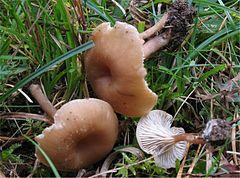| Pseudoomphalina | |
|---|---|
 | |
| Pseudoomphalina kalchbrenneri | |
| Scientific classification | |
| Kingdom: | |
| Division: | |
| Class: | |
| Order: | |
| Family: | |
| Genus: | Pseudoomphalina (Singer) Singer (1956) |
| Type species | |
| Pseudoomphalina kalchbrenneri (Bres.) Singer (1956) | |
| Species | |
| |
| Synonyms[2] | |
| Neohygrophorus Singer ex Singer (1962)[1] | |
Pseudoomphalina is a genus of fungi in the placed in the family Tricholomataceae for convenience. The genus contains six species that are widespread in northern temperate areas.[2][3] Pseudoomphalina was circumscribed by Rolf Singer in 1956.[4] Pseudoomphalina was found to be paraphyletic to Neohygrophorus in a molecular phylogenetics study and since Pseudoomphalina is an older name, Neohygrophyorus was synonymized with it.[2] The type species of Neohygrophorus was Neohygrophorus angelesianus, now Pseudoomphalina angelesiana.[1][2] In earlier classifications based on anatomy prior to DNA sequence-based classifications, its unusual combination of features led taxonomists to independently create two subgenera in two genera: Hygrophorus subg. Pseudohygrophorus[5][6] and Clitocybe subg. Mutabiles;[7][8] the latter based on Neohygrophorus angelesianus but described under a new species name which is now placed in synonymy, Clitocybe mutabilis. All species of Pseudoomphalina are united by the presence of clamp-connections in their hyphae, an interwoven gill trama and amyloid spores. Pseudoomphalina angelesiana possesses grey-violaceous pigments that turn red in alkali solutions and lacks filiform, hyphal sterile elements in its hymenium and stipitipellis.[2] These were features used to distinguish it from Pseudoomphalina as a genus, but Pseudoomphalina umbrinopurpurascens possesses these same pigments and the filiform elements of Pseudoomphalina.[2] Molecular phylogenetics studies have also found some former species of Pseudoomphalina to belong in other genera. Pseudoomphalina pachyphylla was moved to its own genus, Pseudolaccaria, and Pseudoomphalina clusiliformis was synonymized with it.[2] Pseudoomphalina flavoaurantia and Pseudoomphalina lignicola were found to belong in Clitocybula.[9] Phylogenetically, Pseudoomphalina is in a tricholomatoid clade but not in the Tricholomataceae.[10][11]
See also
- List of Tricholomataceae genera
References
- ^ a b Singer R. (1961). "Diagnoses fungorum novorum Agaricalium II". Sydowia. 15 (1–6): 45–83.
- ^ a b c d e f g Vizzini, Alfredo; Ge, Zai-Wei (2015). "Redescription of Clitocybe umbrinopurpurascens (Basidiomycota, Agaricales) and revision of Neohygrophorus and Pseudoomphalina". Phytotaxa. 219 (1): 43–57. doi:10.11646/phytotaxa.219.1.3.
- ^ Kirk PM, Cannon PF, Minter DW, Stalpers JA (2008). Dictionary of the Fungi (10th ed.). Wallingford, Oxford: CAB International. p. 571. ISBN 978-0-85199-826-8.
- ^ Singer R. (1956). "New genera of fungi. VII". Mycologia. 48 (5): 719–27. doi:10.2307/3755381. JSTOR 3755381.
- ^ Hesler LR, Smith AH (1963). North American species of Hygrophorus. Knoxville: University of Tennessee Press. pp. 47–48.
- ^ Smith AH, Hesler LR (1942). "Studies in North American Hygrophorus". Lloydia. 5: 1–94.
- ^ Bigelow HE. (1985). "North American species of Clitocybe". Beihefte zur Nova Hedwigia. 81: 410–412.
- ^ Bigelow HE. (1977). "New taxa of Clitocybe". Mycotaxon. 6: 181–185.
- ^ Malysheva E. F.; Morozova O. V. & Contu M. (2011). "New combinations in Clitocybula: a study of cystidiate Pseudoomphalina species (Basidiomycota, Agaricomycetes)". Sydowia. 63 (1): 85–104.
- ^ Moncalvo JM, Vilgalys R, Redhead SA, Johnson JE, James TY, Catherine Aime M, Hofstetter V, Verduin SJ, Larsson E, Baroni TJ, Greg Thorn R, Jacobsson S, Clémençon H, Miller OK (2002). "One hundred and seventeen clades of euagarics" (PDF). Molecular Phylogenetics and Evolution. 23 (3): 357–400. doi:10.1016/S1055-7903(02)00027-1. PMID 12099793.
- ^ Matheny PB, Curtis JM, Hofstetter V, Aime MC, Moncalvo JM, Ge ZW, Slot JC, Ammirati JF, Baroni TJ, Bougher NL, Hughes KW, Lodge DJ, Kerrigan RW, Seidl MT, Aanen DK, DeNitis M, Daniele GM, Desjardin DE, Kropp BR, Norvell LL, Parker A, Vellinga EC, Vilgalys R, Hibbett DS (2006). "Major clades of Agaricales: a multilocus phylogenetic overview" (PDF). Mycologia. 98 (6): 982–95. doi:10.3852/mycologia.98.6.982. PMID 17486974. Archived from the original (PDF) on 2016-03-03.
External links
- Pseudoomphalina in Index Fungorum
- Mykoweb - Pseudoomphalina angelesiana
- Cripps - Snowbank Fungi Revisited